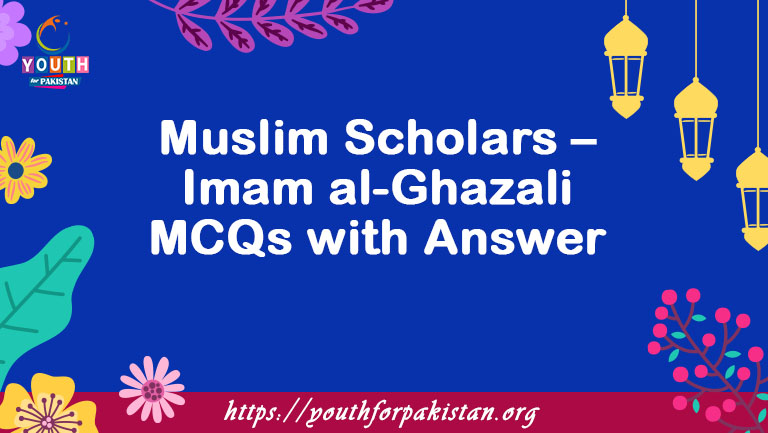The following are Muslim Scholars – Imam al-Ghazali MCQs with answers related to Islamic Studies. We have arranged the most important and repeated MCQs in all the competitive examinations. The students can clear their concepts for Muslim Scholars – Imam al-Ghazali MCQs online quiz by attempting these.
Muslim Scholars – Imam al-Ghazali Online MCQs with Answers
Imam al-Ghazali, known as “Hujjat al-Islam,” was a prominent Islamic theologian, philosopher, and jurist. What does “Hujjat al-Islam” mean?
A) Light of Islam
B) Proof of Islam
C) Guardian of Islam
D) Scholar of Islam
In which Islamic school of thought is Imam al-Ghazali primarily associated?
A) Hanafi
B) Shafi’i
C) Maliki
D) Ash’ari
Imam al-Ghazali’s influential work, “Ihya’u ‘Ulum al-Din” (The Revival of the Religious Sciences), is divided into how many sections?
A) Two
B) Three
C) Four
D) Five
In his philosophical journey, Imam al-Ghazali famously experienced a period of doubt and skepticism. What is the term commonly used to describe this phase?
A) Fitra
B) Taqwa
C) Ihram
D) Incredulity
Imam al-Ghazali’s work “Tahafut al-Falasifah” (The Incoherence of the Philosophers) criticized the ideas of which group of thinkers?
A) Mathematicians
B) Alchemists
C) Philosophers
D) Physicians
What was the
primary aim of Imam al-Ghazali’s work “Ihya’u ‘Ulum al-Din” (The Revival of the Religious Sciences)?
A) To defend atheism
B) To promote mysticism
C) To criticize Sufism
D) To revive Islamic spirituality and ethics
AnswerD) To revive Islamic spirituality and ethics
In his famous work “Alchemy of Happiness” (Kimya-yi Sa’adat), Imam al-Ghazali discusses the importance of what in achieving true happiness?
A) Material wealth
B) Inner peace and spiritual growth
C) Physical health
D) Social status
AnswerB) Inner peace and spiritual growth
Imam al-Ghazali’s “Ihya’u ‘Ulum al-Din” covers various aspects of a Muslim’s life. Which section of the book deals with acts of worship and religious rituals?
A) Kitab al-Tawhid
B) Kitab al-Adhkar
C) Kitab al-Ibadat
D) Kitab al-Qadar
What is the term used to describe Imam al-Ghazali’s approach of combining
Islamic law, theology, philosophy, and mysticism into a cohesive system?
A) Taqlid
B) Tawassul
C) Ijazah
D) Tariqah
Imam al-Ghazali’s influence extended beyond his writings. He also played a significant role in the development of Islamic what?
A) Architecture
B) Art
C) Philosophy
D) Spirituality
Which of the following is not one of the primary sources of
Islamic law (Sharia) that Imam al-Ghazali emphasized in his works?
A) Quran
B) Hadith
C) Ijma (Consensus)
D) Qiyas (Analogy)
Imam al-Ghazali’s theological views were influenced by the Ash’ari school, which is known for its emphasis on what aspect of faith?
A) Rationalism
B) Mysticism
C) Divine decree
D) Free will
In addition to his scholarly pursuits, Imam al-Ghazali also held a teaching position at a prestigious educational institution in Nishapur. What type of institution was it?
A) Mosque
B) Madrasa
C) Monastery
D) University
Imam al-Ghazali’s work “Ihya’u ‘Ulum al-Din” is divided into sections that cover various aspects of a Muslim’s life. Which section deals with moral character and ethics?
A) Kitab al-Tawhid
B) Kitab al-Adhkar
C) Kitab al-Akhlaq
D) Kitab al-Qadar
Imam al-Ghazali’s exploration of mysticism and spirituality led to his association with what Sufi order?
A) Naqshbandi
B) Qadiriyya
C) Chishti
D) Shadhiliyya
Imam al-Ghazali’s book “Tahafut al-Falasifah” (The Incoherence of the Philosophers) is a critique of the philosophical ideas of which group of thinkers?
A) Mathematicians
B) Alchemists
C) Philosophers
D) Physicians
What is the term used to describe the mystical or Sufi path that seeks spiritual closeness to God, which Imam al-Ghazali advocated in his writings?
A) Ijma
B) Ijtihad
C) Tasawwuf
D) Tawhid
In his philosophical work “Tahafut al-Falasifah” (The Incoherence of the Philosophers), Imam al-Ghazali challenged the philosophical concept of what?
A) Divine revelation
B) Divine unity
C) The soul’s immortality
D) Natural selection
AnswerC) The soul’s immortality
Imam al-Ghazali’s philosophical writings had a significant impact on later Muslim philosophers and theologians. Which
famous philosopher was influenced by his ideas?
A) Ibn Sina (Avicenna)
B) Al-Farabi
C) Ibn Khaldun
D) Al-Razi (Rhazes)
AnswerA) Ibn Sina (Avicenna)
In his work “Ihya’u ‘Ulum al-Din,” Imam al-Ghazali addresses various topics related to Islamic practice and spirituality. Which section of the book deals with purification of the heart and intentions?
A) Kitab al-Tawhid
B) Kitab al-Adhkar
C) Kitab al-Ibadat
D) Kitab al-Tasfiyah wa al-Tarbiyah
AnswerD) Kitab al-Tasfiyah wa al-Tarbiyah
What is the term used to describe Imam al-Ghazali’s approach of combining Islamic law, theology, philosophy, and mysticism into a cohesive system?
A) Taqlid
B) Tawassul
C) Ijazah
D) Tariqah
Which of the following is a
famous book written by Imam al-Ghazali that addresses the importance of acquiring knowledge and the path to spiritual awakening?
A) “Tahafut al-Falasifah”
B) “Ihya’u ‘Ulum al-Din”
C) “Al-Munqidh min al-Dalal”
D) “Al-Maqsad al-Asna”
AnswerC) “Al-Munqidh min al-Dalal”
Imam al-Ghazali’s philosophical work “Tahafut al-Falasifah” is considered a landmark in Islamic philosophy and theology. What is its English translation often titled as?
A) “The Revival of the Religious Sciences”
B) “The Incoherence of the Philosophers”
C) “The Book of Guidance”
D) “The Alchemy of Happiness”
AnswerB) “The Incoherence of the Philosophers”
Imam al-Ghazali’s influence extended beyond his writings. He also played a significant role in the development of Islamic what?
A) Architecture
B) Art
C) Philosophy
D) Spirituality
What was the primary aim of Imam al-Ghazali’s work “Ihya’u ‘Ulum al-Din” (The Revival of the Religious Sciences)?
A) To defend atheism
B) To promote mysticism
C) To criticize Sufism
D) To revive Islamic spirituality and ethics
AnswerD) To revive Islamic spirituality and ethics
In addition to his scholarly pursuits, Imam al-Ghazali also held a teaching position at a prestigious educational institution in Nishapur. What type of institution was it?
A) Mosque
B) Madrasa
C) Monastery
D) University
Imam al-Ghazali’s exploration of mysticism and spirituality led to his association with what Sufi order?
A) Naqshbandi
B) Qadiriyya
C) Chishti
D) Shadhiliyya
In his work “Ihya’u ‘Ulum al-Din,” Imam al-Ghazali addresses various topics related to Islamic practice and spirituality. Which section of the book deals with purification of the heart and intentions?
A) Kitab al-Tawhid
B) Kitab al-Adhkar
C) Kitab al-Ibadat
D) Kitab al-Tasfiyah wa al-Tarbiyah
AnswerD) Kitab al-Tasfiyah wa al-Tarbiyah
Imam al-Ghazali’s philosophical writings had a significant impact on later Muslim philosophers and theologians. Which famous philosopher was influenced by his ideas?
A) Ibn Sina (Avicenna)
B) Al-Farabi
C) Ibn Khaldun
D) Al-Razi (Rhazes)
AnswerA) Ibn Sina (Avicenna)
What is the term used to describe the mystical or Sufi path that seeks spiritual closeness to God, which Imam al-Ghazali advocated in his writings?
A) Ijma
B) Ijtihad
C) Tasawwuf
D) Tawhid
In his philosophical work “Tahafut al-Falasifah” (The Incoherence of the Philosophers), Imam al-Ghazali challenged the philosophical concept of what?
A) Divine revelation
B) Divine unity
C) The soul’s immortality
D) Natural selection
AnswerC) The soul’s immortality
Imam al-Ghazali’s influence extended beyond his writings. He also played a significant role in the development of Islamic what?
A) Architecture
B) Art
C) Philosophy
D) Spirituality
What was the primary aim of Imam al-Ghazali’s work “Ihya’u ‘Ulum al-Din” (The Revival of the Religious Sciences)?
A) To defend atheism
B) To promote mysticism
C) To criticize Sufism
D) To revive Islamic spirituality and ethics
AnswerD) To revive Islamic spirituality and ethics
In addition to his scholarly pursuits, Imam al-Ghazali also held a teaching position at a prestigious educational institution in Nishapur. What type of institution was it?
A) Mosque
B) Madrasa
C) Monastery
D) University
Imam al-Ghazali’s exploration of mysticism and spirituality led to his association with what Sufi order?
A) Naqshbandi
B) Qadiriyya
C) Chishti
D) Shadhiliyya
In his work “Ihya’u ‘Ulum al-Din,” Imam al-Ghazali addresses various topics related to Islamic practice and spirituality. Which section of the book deals with purification of the heart and intentions?
A) Kitab al-Tawhid
B) Kitab al-Adhkar
C) Kitab al-Ibadat
D) Kitab al-Tasfiyah wa al-Tarbiyah
AnswerD) Kitab al-Tasfiyah wa al-Tarbiyah
Imam al-Ghazali’s philosophical writings had a significant impact on later Muslim philosophers and theologians. Which famous philosopher was influenced by his ideas?
A) Ibn Sina (Avicenna)
B) Al-Farabi
C) Ibn Khaldun
D) Al-Razi (Rhazes)
AnswerA) Ibn Sina (Avicenna)
What is the term used to describe the mystical or Sufi path that seeks spiritual closeness to God, which Imam al-Ghazali advocated in his writings?
A) Ijma
B) Ijtihad
C) Tasawwuf
D) Tawhid
In his philosophical work “Tahafut al-Falasifah” (The Incoherence of the Philosophers), Imam al-Ghazali challenged the philosophical concept of what?
A) Divine revelation
B) Divine unity
C) The soul’s immortality
D) Natural selection
AnswerC) The soul’s immortality
Imam al-Ghazali’s influence extended beyond his writings. He also played a significant role in the development of Islamic what?
A) Architecture
B) Art
C) Philosophy
D) Spirituality
What was the primary aim of Imam al-Ghazali’s work “Ihya’u ‘Ulum al-Din” (The Revival of the Religious Sciences)?
A) To defend atheism
B) To promote mysticism
C) To criticize Sufism
D) To revive Islamic spirituality and ethics
AnswerD) To revive Islamic spirituality and ethics
In addition to his scholarly pursuits, Imam al-Ghazali also held a teaching position at a prestigious educational institution in Nishapur. What type of institution was it?
A) Mosque
B) Madrasa
C) Monastery
D) University
Imam al-Ghazali’s exploration of mysticism and spirituality led to his association with what Sufi order?
A) Naqshbandi
B) Qadiriyya
C) Chishti
D) Shadhiliyya
In his work “Ihya’u ‘Ulum al-Din,” Imam al-Ghazali addresses various topics related to Islamic practice and spirituality. Which section of the book deals with purification of the heart and intentions?
A) Kitab al-Tawhid
B) Kitab al-Adhkar
C) Kitab al-Ibadat
D) Kitab al-Tasfiyah wa al-Tarbiyah
AnswerD) Kitab al-Tasfiyah wa al-Tarbiyah
Imam al-Ghazali’s philosophical writings had a significant impact on later Muslim philosophers and theologians. Which famous philosopher was influenced by his ideas?
A) Ibn Sina (Avicenna)
B) Al-Farabi
C) Ibn Khaldun
D) Al-Razi (Rhazes)
AnswerA) Ibn Sina (Avicenna)
What is the term used to describe the mystical or Sufi path that seeks spiritual closeness to God, which Imam al-Ghazali advocated in his writings?
A) Ijma
B) Ijtihad
C) Tasawwuf
D) Tawhid
In his philosophical work “Tahafut al-Falasifah” (The Incoherence of the Philosophers), Imam al-Ghazali challenged the philosophical concept of what?
A) Divine revelation
B) Divine unity
C) The soul’s immortality
D) Natural selection
AnswerC) The soul’s immortality
Imam al-Ghazali’s influence extended beyond his writings. He also played a significant role in the development of Islamic what?
A) Architecture
B) Art
C) Philosophy
D) Spirituality
What was the primary aim of Imam al-Ghazali’s work “Ihya’u ‘Ulum al-Din” (The Revival of the Religious Sciences)?
A) To defend atheism
B) To promote mysticism
C) To criticize Sufism
D) To revive Islamic spirituality and ethics
AnswerD) To revive Islamic spirituality and ethics
In addition to his scholarly pursuits, Imam al-Ghazali also held a teaching position at a prestigious educational institution in Nishapur. What type of institution was it?
A) Mosque
B) Madrasa
C) Monastery
D) University
Was this article helpful?
YesNo










